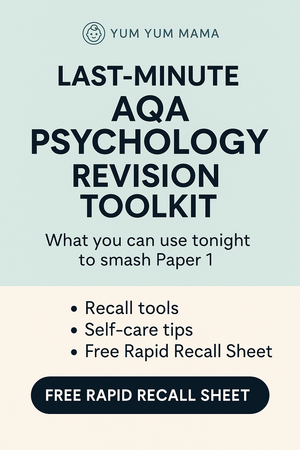Discuss research into minority influence. (8 marks)
Want Tailored A* Model Answers Sent Straight to Your Inbox?
Pick your topics below and we’ll send you the exact model essays you need – no fluff, no stress. Just real help for real grades.
Model Answer
One key study into minority influence is Moscovici et al. (1969), who investigated how a consistent minority could influence a majority in a colour perception task.
In the study, participants were shown blue slides, but confederates (the minority) consistently said they were green.
Moscovici found that consistent minorities influenced participants to give the wrong answer in 8.42% of trials, suggesting that consistency can increase minority influence.
One strength of Moscovici’s research is that it was conducted in a controlled laboratory setting.
This is because the researchers could carefully control variables such as the colour and lighting of the slides, ensuring the only influence was the minority opinion.
This is a strength because it increases internal validity, making it more likely that changes in participants’ responses were due to the independent variable – the behaviour of the minority – rather than extraneous variables.
One limitation is that the research lacks ecological validity.
This is because judging slide colours is an artificial task that does not reflect real-life minority influence situations, such as civil rights movements or social change.
This is a problem because the findings may not generalise to real-world scenarios where consequences are more significant, reducing the external validity of the study.
How to write a top band answer and understand what examiners are really looking for
How to write a top band answer and understand what examiners are really looking for
Once you've read a model answer to the question "Discuss research into minority influence (8 marks)," the next step is understanding why it earns top marks—and how you can write your own answers to that standard.
This is a common essay question in AQA Psychology, and many students search online for phrases like:
-
What is research into minority influence?
-
What is consistency and flexibility in minority influence (8 marks)?
-
What was Moscovici's experiment?
-
Discuss research into minority influence model answer
-
Discuss consistency and flexibility as processes involved in minority influence (8 marks)
This article is here to guide you through all of that, but with one clear goal: helping you improve your exam technique.
What does “discuss” really mean in an 8-mark question?
In AQA Psychology, the command word “discuss” requires both AO1 and AO3:
-
AO1 (3 marks): You need to accurately describe a psychological study or concept—in this case, research into minority influence.
-
AO3 (5 marks): You must provide two well-developed evaluation points (strengths or limitations), ideally using a clear structure such as Point → Because → Why.
Why is Moscovici’s study so important?
A top-level answer almost always includes Moscovici et al. (1969). In his classic experiment, groups of six participants were shown blue slides, but two of the group were confederates (i.e., part of the research team). These confederates consistently claimed the slides were green. Surprisingly, 8.42% of the participants conformed to this incorrect minority view at least once.
This study showed that a consistent minority can influence the majority, even when the task is straightforward. That’s a key takeaway.
But don’t stop at describing the study—go further by evaluating it. For example, you could explain that the controlled lab setting increases internal validity, or that the artificial task reduces ecological validity. This is what pushes an answer into the top band.
The power of terminology
Top-level essays also use psychological terminology fluently. That means including and explaining key terms such as:
-
Minority influence – when a small group influences the beliefs or behaviour of a larger group
-
Consistency – the minority sticks to their viewpoint over time
-
Flexibility – the minority shows willingness to compromise
-
Internalisation – the process by which people genuinely adopt the minority view
-
Ecological validity – whether the findings can be applied to real-life situations
Using these terms accurately and appropriately can boost your marks in both AO1 and AO3.
Where does flexibility come in?
Although Moscovici focused on consistency, later research emphasised the importance of flexibility. For instance, Nemeth (1986) found that minorities who were too rigid were less persuasive. When minorities showed flexibility—adapting their position slightly—they were more likely to influence the majority.
If the question was: “Discuss consistency and flexibility as processes involved in minority influence (8 marks),” your AO1 would need to include both of these ideas, supported by research. Your AO3 could then evaluate how effective these processes are in real-world settings or how well the studies reflect actual minority movements.
How would this look in a 16-mark essay?
If the question appeared as a 16-marker—such as “Discuss research into minority influence (16 marks)”—the core principles are the same, but the depth is greater.
Your structure would be:
-
AO1: 6 marks – Around six well-developed sentences explaining studies (Moscovici, possibly Nemeth), and the key concepts: consistency, commitment, flexibility, and internalisation.
-
AO3: 10 marks – Four clear evaluation paragraphs. These should include:
-
Strength of lab control in Moscovici’s study
-
Limitation of ecological validity
-
Real-world application to social change (e.g., civil rights movements)
-
The importance of flexibility (with reference to Nemeth) and a counterpoint about its limitations
-
A brief introduction and conclusion are optional, but they can help frame your argument and bring clarity to discussion.
What examiners look for in top band responses
Here’s a summary of the key features that make a top-level answer stand out:
-
Clarity – No vague phrases like “this shows it works.” Be specific.
-
Accuracy – Dates, percentages, and names must be correct (e.g., Moscovici et al., 1969; 8.42%).
-
Relevance – Everything you write should relate directly to the question.
-
Structure – Use clear AO1 and AO3 paragraphs. In evaluation, follow Point → Because → Why.
-
Balance – Two strong AO3 paragraphs for an 8-marker, and four for a 16-marker.
Final revision tips
Many students benefit from active recall. Ask yourself:
-
What did Moscovici’s study show?
-
Why does consistency matter?
-
What’s the role of flexibility in minority influence?
-
How do minority influence and majority influence differ?
Answering these aloud, writing them out from memory, or using flashcards will help you retain and apply the information in exam conditions.
You don’t need to memorise full essays—but you do need to practise structuring answers, applying studies, and writing clearly.
If you’re ready to test your knowledge, check out our downloadable revision guide and flashcards. You can also try our quiz version of “Discuss research into minority influence – 8 marks” to check your understanding under timed conditions.


